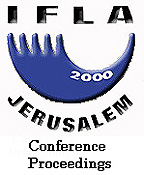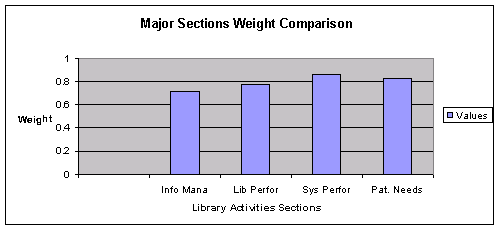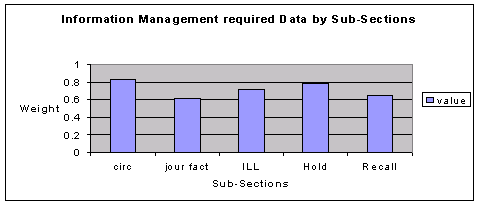 66th IFLA Council and General
Conference
Jerusalem, Israel, 13-18 August
Code Number: 022-129-E
Division Number: VI
Professional Group: VI
Joint Meeting with: -
Meeting Number: 129
Simultaneous Interpretation:
No
Library Management Systems and the Statistical Requirements of Library and Information ManagersDavid Amitai
E-mail : david.amitai@exlibris.co.il
&
Noam Kaminer
E-mail : noam.kaminer@exlibris.co.il
Ex Libris Ltd.
Tel Aviv , Israel
AbstractThe management of a library is based to a large extent on the availability of relevant statistical output. LMS vendors are not always clear on the required statistics that their library system should generate. In a survey conducted among library and information managers from diverse library types and cultural backgrounds it was found that the most valued statistics were those related to circulation, system performance, and search aspects. However, various suggestions for additional required statistics as reflected in the survey may suggest that an Open System approach should be adopted by the LMS vendors. This approach could enable the generation of any required report by querying the library's stored data directly via 3rd party tools such as SQL , Power Builder, Crystal Reports, etc.
Paper
Introduction:
Provision of efficient and cost-effective information services requires, among other things,a relevant statistical output on which library and information managers could base their policy decisions.
Vendors of Library Management Systems (LMS) are often asked whether their system has an ample functionality (e.g., a statistical module) to support managerial decision-making. However, it is not always clear what specific objectives such functionality should be designed to support. It seems that the whole issue needs to be more clearly defined.
Our survey intended to gather information on the actual statistical requirements of library managers so as to facilitate a better understanding of their needs in this area. It is our hope that the information obtained will make it easier for LMS producers to accommodate these essential needs when designing their future products.
Method:
A detailed questionnaire, consisting of 50 items, questions and statements, was distributed to 270 library heads and managers worldwide, from among Ex Libris customers. The questionnaire items were divided into four major sections, which we believe reflects four distinguishable groups of core activities within the current automated library environment:
- Information Management, for statistics related to activities such as Circulation, Recall, ILL requests, Holds requests, Routing lists, and SDI/Current Awareness services.
- Library Performance, for data generated by measurement of workflow, breakdown of various services, budget utilization, IPs usage (searches distribution), and library usage.
- System Performance, for system response time statistics.
- Patron Needs and Behavior, for statistics related to database usage and employed search modes, search commands and indexes.
Additional sections in the questionnaire provided for libraries' general information and for additional required statistics suggested by the respondents.
For each question or statement within the four above-mentioned sections, the respondent was asked to rate the indicated statistical output on a scale of 1 to 5 (not important - very important, consecutively). For each questionnaire item in the four major sections, all the assigned values were added and divided by the maximum value possible for this item (i.e.,the number of actual responses multiplied by 5) . In this way the relative weight for each item was calculated on a scale of 0 to 1.
Example: for question 1.1.2, the importance of collected statistics for the number of loans per patron, we received 26 responses, as follow: one gave it 2, eight gave it 3, another group of eight gave it 4, and nine gave it 5. The calculating formula (1x2)+(8x3)+(8x4)+(9x5)/(26x5) or 103/130, resulted in the relative weight for this question, which was 0.792307692.
Based on the relative weight of the 50 questions and statements, we tried to single out the items which library managers most valued, to find out which group of library activities (major section) is more valued for statistical purposes by comparing the combined relative weight of all four sections, and to indicate accordingly the preferred sub-sections within a major section, wherver applicable.
Findings:
From the 270 questionnaires sent out 29 were received back (10.74 %). The respondents were mixed in terms of library types (academic, national, and corporate) and geographical areas (Mediterranean, Europe, South and North America).
In this paper we would like to focus on the following findings:
- The statistical data items that received the highest relative weight, 0.9 and up, were:
- Number of loans per item - (Information Management section, Circulation)
- Number of items loaned - (Information Management section, Circulation)
- Number of Hold requests on the bibliographical level - (Information Managment, Hold requests)
- Breakdown of database usage by number of users - (Patron's Needs and Behavior section)
- Breakdown of database usage by number of queries - (Patron's Needs and Behavior section)
Other interesting data items with a relative weight between 0.8-0.9 include: mean time for query and results display; search distribution by IPs; search modes used; indexes used in searches; breakdown of loans by major subject categories; number of Hold requests on the subject level; cataloging productivity.
- A comparison of the relative weights for the different major activities sections, displayed below, may indicate a growing interest in system and database usage related statistics (System Performance and Patron's Needs sections) over more traditional aspects of library activities like circulation and measurement of services (Information Management and Library Performance sections). This finding should be taken as a possible non-conclusive indication, since the difference in the number of questionnaire items for each section may account for the difference in the section's combined relative weight. In other words, the System Performance

section may have gained higher relative weight due to the fewer and more homogenized items it contains, as compared with the rest of the sections.
- A comparison of the relative weight for the sub-sections of the Information Management section, displayed below, shows clearly that circulation activity is the statistical output most in demand. Also highly valued are Hold Request statistics. On the other hand, the survey respondents gave significantly less value toJournal Factor and Recall statistics.
Discussion:
From the findings described above one should be on safe ground when concluding that statistics regarding circulation activity are those which are most required by library managers. This reasoning is supported both by a comparison of the sub-sections on Information Management (finding 3) and by the fact that two of the five highest-rated questionnaire items are circulation- related (finding 1).

Statistics related to the technical aspects of the library system, such as response time and measurements of database usage, are also very much required. This is demonstrated by two other items from the five which were rated highest (finding 1) and the comparison of the relative weights calculated for the four major library activity sections (finding 2). These results should come as no surprise in an age where a library's claim to fame often depends on its computerized infrastructure.
Besides these two types of library activity data, statistics related to search aspects (IPs distribution, indexes used, etc.) were considered to be very significant for most respondents. Again, this is very much in line with the currently evolving library environment.
On the other hand, the diversity of additional required statistics suggested by the respondents is noteworthy. It may suggest that despite the importance given to statistics for circulation, system performance, and search aspects, the constitution of a definitive list of library required statistics might be neither practical nor desirable. Instead, an Open System approach may serve LMS more favorably in addressing this issue, where, for example, apart from a built-in package of the most common reports, every other statistical report could be generated by querying the library's stored data directly (e.g., via the use of SQL or other report generating tools such as Power Builder, Crystal Reports, etc.)
Final note: without making any claim to being conclusive, the findings of this survey may be further enhanced given the previously mentioned mixed background of its respondents both library-wise and geographically/culturally. Nonetheless, further exploration of the issues discussed above calls for a survey to be conducted on a larger scale.
Conclusions:
Our small-scale survey was able to draw common patterns in regard to required statistics among a diverse group of library managers. Circulation, system performance, and various search aspects were rated as those most required for statistical purposes. Another pattern which emerged was in regard to the different needs and additional statistics required by various library sites. Due to these differences a definitive needs list may not be the LMS vendors' best choice for statistics in library. A mixed approach may indeed satisfy more of these requirements for more sites by offering a package of ready-made reports and allow for customized reports to be generated through direct querying of the library's stored data (The Open System approach, as exemplified by the use of SQL and other 3rd party tools).
|






